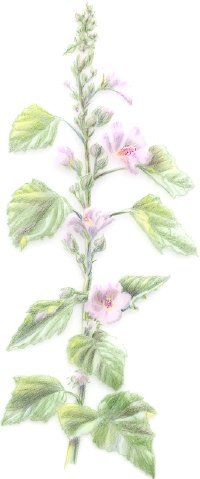The mallow family includes the beautiful hibiscus (Hibiscus rosa-sinensis), whose large, colorful blossoms grace Hawaii and other tropical environs, and hollyhocks (Althea rosacea), a summer garden favorite throughout Europe and North America. It is used by herbalists in several herbal remedies.
All of the mallows bear lovely but short-lasting blossoms with thin, moist petals that become sticky if crushed. Althea is from the Greek althino, meaning "I cure." It is so named because mallow has been used medicinally for centuries. The Greeks used marshmallow to treat wounds, toothaches, coughing, and insect stings. The Romans valued marshmallow roots and leaves for their laxative properties. Mallow is mentioned by Hippocrates and Culpepper in their herbal treatises. The confection marshmallows are so named because they were originally flavored with the roots of this herb.
Advertisement
arshmallow
Mallow is used as a soothing demulcent to help heal skin, wounds, and internal tissues. The bladder responds particularly well to mallow preparations. With the help of a skilled herbalist, many people may improve chronic bladder infections and avoid repeated antibiotic therapy. Mallow also may be used for stomach irritation and ulcers, sore throats, coughs, and bronchitis. Mallow preparations may be used topically to treat abrasions, rashes, and inflammations.
Keep reading to learn about marshmallow preparations and warnings.
To learn more about treating common medical conditions at home, try the following links:
- For an overview of all of our herbal remedies, go to the main Herbal Remedies page.
- To learn more about treating medical conditions at home, visit our main Home Remedies page.
- One of the best things you can do for your health and well being is to make sure you are getting enough of the vital nutrients your body needs. Visit our Vitamins page to learn more.
This information is solely for informational purposes. IT IS NOT INTENDED TO PROVIDE MEDICAL ADVICE. Neither the Editors of Consumer Guide (R), Publications International, Ltd., the author nor publisher take responsibility for any possible consequences from any treatment, procedure, exercise, dietary modification, action or application of medication which results from reading or following the information contained in this information. The publication of this information does not constitute the practice of medicine, and this information does not replace the advice of your physician or other health care provider. Before undertaking any course of treatment, the reader must seek the advice of their physician or other health care provider.Before engaging in any complementary medical technique, including the use of natural or herbal remedies, you should be aware that many of these techniques have not been evaluated in scientific studies. Use of these remedies in connection with over the counter or prescription medications can cause severe adverse reactions. Often, only limited information is available about their safety and effectiveness. Each state and each discipline has its own rules about whether practitioners are required to be professionally licensed. If you plan to visit a practitioner, it is recommended that you choose one who is licensed by a recognized national organization and who abides by the organization's standards. It is always best to speak with your primary health care provider before starting any new therapeutic technique.
Advertisement
